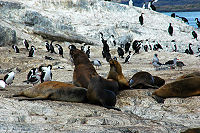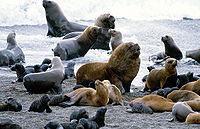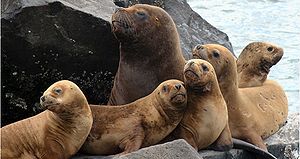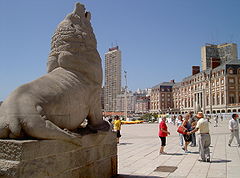
South American Sea Lion
Encyclopedia
The South American sea lion (Otaria flavescens, formerly Otaria byronia), also called the southern sea lion and the Patagonian sea lion, is a sea lion
found on the Chile
an, Peru
vian, Uruguay
an, Argentine
and Southern Brazilian coasts. It is the only member of the genus Otaria. Its scientific name was subject to controversy, with some taxonomists referring to it as Otaria flavescens and others referring to it as Otaria byronia. The former eventually won out. Locally, it is known by several names though the most common ones are lobo marino (sea wolf) and león marino (sea lion).
esque of the eared seals. They are twice the weight of females. Both males and females are orange or brown coloured with upturned snouts. Pups are born greyish orange ventrally and black dorsally and moult into a more chocolate colour.
The South American sea lion's size and weight can vary considerably. Adult males can grow over 2.73 m (9 ft) and weigh up to 350 kg (770 lb
). Adult females grow up to 1.8–2 m (6–7 ft) and weigh about half the weight of the males, around 150 kg (330 lb). These sea lions are the most sexually dimorphic of the five sea lion species.
 As its name suggests, the South American sea lion is found along the coasts and offshore islands of South America. It ranges from Peru south to Chile in the Pacific and then north to southern Brazil in the Atlantic. It generally breeds in the southern part of its range and travels north in winter and spring. Notable breeding colonies include Lobos Island
As its name suggests, the South American sea lion is found along the coasts and offshore islands of South America. It ranges from Peru south to Chile in the Pacific and then north to southern Brazil in the Atlantic. It generally breeds in the southern part of its range and travels north in winter and spring. Notable breeding colonies include Lobos Island
, Uruguay; Peninsula Valdes, Argentina; Beagle Channel
and the Falkland Islands
. Some individuals wander as far north as southern Ecuador
, although apparently they never bred there.
South American sea lions prefer to breed on beach
es made of sand, but will breed on gravel
, rocky or pebble
beaches, as well. They can also be seen on flat rocky cliffs with tidepools. Sea lion colonies are more scattered on rocky beaches than sand, gravel or pebble beaches. The colonies make spaces between each individual when it is warm and sunny. They can also be found in marina
s and wharves but do not breed there.
South American sea lions feed on a variety of fish
, including Argentine hake
and anchovies
. They also eat cephalopod
s, such as shortfin squid
, Patagonian squid and octopus
. They have even been observed preying on penguin
s, pelican
s and young South American fur seal
s. South American sea lions normally hunt in shallow waters less than five miles from shore. They often forage at the ocean floor for slow moving prey, but they will also hunt schooling prey in groups. When captured, the prey is shaken violently and torn apart. South American sea lions have been recorded to take advantage
of the hunting efforts of dusky dolphin
s, feeding on the fish they herd together. The sea lions themselves are preyed on by orca
s and shark
s.
 Mating occurs between August and December, and the pups are born between December and February. Males arrive first to establish and defend territories, but then switch to defending females when they arrive. Males will fight and use threat displays towards neighbours and intruders to protect both their territories and females. A male will forcefully keep pre-estrous females near him. On rocky beaches, males defend small territories where females aggregate and herd them. On cobble or sandy beaches, which are longer and broader, males stay along the surf line and try to herd females going to sea to cool down or forage. The number of actual fights between males depends on the number of females in heat. The earlier a male arrives at the site the longer his tenure will be and the more copulations he will achieve. Males are usually able to keep around three females in their harem, but some have as many as 18.
Mating occurs between August and December, and the pups are born between December and February. Males arrive first to establish and defend territories, but then switch to defending females when they arrive. Males will fight and use threat displays towards neighbours and intruders to protect both their territories and females. A male will forcefully keep pre-estrous females near him. On rocky beaches, males defend small territories where females aggregate and herd them. On cobble or sandy beaches, which are longer and broader, males stay along the surf line and try to herd females going to sea to cool down or forage. The number of actual fights between males depends on the number of females in heat. The earlier a male arrives at the site the longer his tenure will be and the more copulations he will achieve. Males are usually able to keep around three females in their harem, but some have as many as 18.
 During the breeding season, males that fail to secure territories and harems, most often sub-adults, will cause group raids in an attempt to change the status-quo and gain access to the females. Group raids are more common on sandy beaches than rocky ones. These raids cause chaos in the breeding harems, often splitting mothers from their young. The resident males will try to fight off the raiders and keep all the females in their territorial boundaries. Raiders are often unsuccessful in securing a female, however some are able to capture some females or even depose of a resident male and remain in the breeding area with one or more females. Sometimes an invading male will abduct pups, possibly as an attempt to control the females. They also take pups as substitutes for mature females. Sub-adults will herd their captured pups and prevent them from escaping, much like what adult males do to females. A pup may be mounted by its abductor but intromission does not occur. While abducting pups does not give males immediate reproductive benefits, these males may gain experience in controlling females. Pups are sometimes severely injured or killed during abductions.
During the breeding season, males that fail to secure territories and harems, most often sub-adults, will cause group raids in an attempt to change the status-quo and gain access to the females. Group raids are more common on sandy beaches than rocky ones. These raids cause chaos in the breeding harems, often splitting mothers from their young. The resident males will try to fight off the raiders and keep all the females in their territorial boundaries. Raiders are often unsuccessful in securing a female, however some are able to capture some females or even depose of a resident male and remain in the breeding area with one or more females. Sometimes an invading male will abduct pups, possibly as an attempt to control the females. They also take pups as substitutes for mature females. Sub-adults will herd their captured pups and prevent them from escaping, much like what adult males do to females. A pup may be mounted by its abductor but intromission does not occur. While abducting pups does not give males immediate reproductive benefits, these males may gain experience in controlling females. Pups are sometimes severely injured or killed during abductions.
Sea lion mothers remain with their newborn pups for nearly a week before making routine of taking three day foraging trips and coming back to nurse the pups. They will act aggressively to other females who come close to their pups, as well as alien pups who try to get milk from them. Pups first enter the water at about four weeks and are weaned at about 12 months. This is normally when the mother gives birth to a new pup. Pups gradually spent more time in the nearshore surf and develop swimming skills.
South American sea lions are observed to make various vocalizations and calls which differs between sexes and ages. Adult males will make high-pitched calls during aggressive interactions, barks when establishing territories, growls when interacting with females, and exhalations which are made after agonistic encounters. Females who have pups make what is called a mother primary call when interacting with their pups, and grunts during aggressive encounters with other females. Pups make what are called pup primary calls. Some of those vocalizations and acoustic features may support individuality.
 The Moche
The Moche
people of ancient Peru
worshipped the sea and its animals. They often depicted South American sea lions in their art. A statue of this species is a symbol of Mar del Plata
.
Indigenous peoples of South America have hunted South American sea lions for thousands of years and at least 16th century European have hunted them food, oil and hides. The hunting has since gone down and the species is no longer threatened. The species is protected in most of its range. Numerous reserves and protected areas at rookeries and haul-out sites, especially in Argentina, have been established and have given the sea lion much protection. Despite this, enforcement of protection regulations is weak in most of the animal's range, especially in the most isolated areas and at sea.
The population estimate is 265,000 animals. They are increasing in Argentina, but are declining in Chile and Uruguay. Many sea lions of the Peruvian population died in the 1997/1998 el Niño. They still are killed due to the sea lions' habits of stealing fish and damaging fishing nets. Sea lions in the port of Mar del Plata have been found with toxic chemicals and heavy metals in their systems. The overall population of sea lions is considered stable.
Sea Lion
Sea lions are pinnipeds characterized by external ear-flaps, long fore-flippers, the ability to walk on all fours, and short thick hair. Together with the fur seal, they comprise the family Otariidae, or eared seals. There are six extant and one extinct species in five genera...
found on the Chile
Chile
Chile ,officially the Republic of Chile , is a country in South America occupying a long, narrow coastal strip between the Andes mountains to the east and the Pacific Ocean to the west. It borders Peru to the north, Bolivia to the northeast, Argentina to the east, and the Drake Passage in the far...
an, Peru
Peru
Peru , officially the Republic of Peru , is a country in western South America. It is bordered on the north by Ecuador and Colombia, on the east by Brazil, on the southeast by Bolivia, on the south by Chile, and on the west by the Pacific Ocean....
vian, Uruguay
Uruguay
Uruguay ,officially the Oriental Republic of Uruguay,sometimes the Eastern Republic of Uruguay; ) is a country in the southeastern part of South America. It is home to some 3.5 million people, of whom 1.8 million live in the capital Montevideo and its metropolitan area...
an, Argentine
Argentina
Argentina , officially the Argentine Republic , is the second largest country in South America by land area, after Brazil. It is constituted as a federation of 23 provinces and an autonomous city, Buenos Aires...
and Southern Brazilian coasts. It is the only member of the genus Otaria. Its scientific name was subject to controversy, with some taxonomists referring to it as Otaria flavescens and others referring to it as Otaria byronia. The former eventually won out. Locally, it is known by several names though the most common ones are lobo marino (sea wolf) and león marino (sea lion).
Physical description
The South American sea lion is perhaps the archetypal sea lion in appearance. Males have a very large head with a well-developed mane, making them the most lionLion
The lion is one of the four big cats in the genus Panthera, and a member of the family Felidae. With some males exceeding 250 kg in weight, it is the second-largest living cat after the tiger...
esque of the eared seals. They are twice the weight of females. Both males and females are orange or brown coloured with upturned snouts. Pups are born greyish orange ventrally and black dorsally and moult into a more chocolate colour.
The South American sea lion's size and weight can vary considerably. Adult males can grow over 2.73 m (9 ft) and weigh up to 350 kg (770 lb
Pound (mass)
The pound or pound-mass is a unit of mass used in the Imperial, United States customary and other systems of measurement...
). Adult females grow up to 1.8–2 m (6–7 ft) and weigh about half the weight of the males, around 150 kg (330 lb). These sea lions are the most sexually dimorphic of the five sea lion species.
Ecology

Isla de Lobos
The Isla de Lobos is a small island located about southeast of Punta del Este . An islet lies east of the island.- Geography :The island is an outcropping of rocks that is a continuation of the Cuchilla Grande, in an area of Atlantic Ocean immediately at the mouth of the estuary of Río de la Plata...
, Uruguay; Peninsula Valdes, Argentina; Beagle Channel
Beagle Channel
thumb|right|300px|Aereal view of Beagle Channel. The Chilean [[Navarino Island]] is seen in the top-right while the Argentine part of [[Isla Grande de Tierra del Fuego]] is seen at the bottom-left....
and the Falkland Islands
Falkland Islands
The Falkland Islands are an archipelago in the South Atlantic Ocean, located about from the coast of mainland South America. The archipelago consists of East Falkland, West Falkland and 776 lesser islands. The capital, Stanley, is on East Falkland...
. Some individuals wander as far north as southern Ecuador
Ecuador
Ecuador , officially the Republic of Ecuador is a representative democratic republic in South America, bordered by Colombia on the north, Peru on the east and south, and by the Pacific Ocean to the west. It is one of only two countries in South America, along with Chile, that do not have a border...
, although apparently they never bred there.
South American sea lions prefer to breed on beach
Beach
A beach is a geological landform along the shoreline of an ocean, sea, lake or river. It usually consists of loose particles which are often composed of rock, such as sand, gravel, shingle, pebbles or cobblestones...
es made of sand, but will breed on gravel
Gravel
Gravel is composed of unconsolidated rock fragments that have a general particle size range and include size classes from granule- to boulder-sized fragments. Gravel can be sub-categorized into granule and cobble...
, rocky or pebble
Pebble
A pebble is a clast of rock with a particle size of 4 to 64 millimetres based on the Krumbein phi scale of sedimentology. Pebbles are generally considered to be larger than granules and smaller than cobbles . A rock made predominantly of pebbles is termed a conglomerate...
beaches, as well. They can also be seen on flat rocky cliffs with tidepools. Sea lion colonies are more scattered on rocky beaches than sand, gravel or pebble beaches. The colonies make spaces between each individual when it is warm and sunny. They can also be found in marina
Marina
A marina is a dock or basin with moorings and supplies for yachts and small boats.A marina differs from a port in that a marina does not handle large passenger ships or cargo from freighters....
s and wharves but do not breed there.
South American sea lions feed on a variety of fish
Fish
Fish are a paraphyletic group of organisms that consist of all gill-bearing aquatic vertebrate animals that lack limbs with digits. Included in this definition are the living hagfish, lampreys, and cartilaginous and bony fish, as well as various extinct related groups...
, including Argentine hake
Merlucciidae
Merlucciidae is a family of cod-like fish, including most hakes.They are native to the Atlantic and Pacific oceans, being common in southern waters off Tasmania and New Zealand....
and anchovies
Anchovy
Anchovies are a family of small, common salt-water forage fish. There are 144 species in 17 genera, found in the Atlantic, Indian, and Pacific Oceans. Anchovies are usually classified as an oily fish.-Description:...
. They also eat cephalopod
Cephalopod
A cephalopod is any member of the molluscan class Cephalopoda . These exclusively marine animals are characterized by bilateral body symmetry, a prominent head, and a set of arms or tentacles modified from the primitive molluscan foot...
s, such as shortfin squid
Squid
Squid are cephalopods of the order Teuthida, which comprises around 300 species. Like all other cephalopods, squid have a distinct head, bilateral symmetry, a mantle, and arms. Squid, like cuttlefish, have eight arms arranged in pairs and two, usually longer, tentacles...
, Patagonian squid and octopus
Octopus
The octopus is a cephalopod mollusc of the order Octopoda. Octopuses have two eyes and four pairs of arms, and like other cephalopods they are bilaterally symmetric. An octopus has a hard beak, with its mouth at the center point of the arms...
. They have even been observed preying on penguin
Penguin
Penguins are a group of aquatic, flightless birds living almost exclusively in the southern hemisphere, especially in Antarctica. Highly adapted for life in the water, penguins have countershaded dark and white plumage, and their wings have become flippers...
s, pelican
Pelican
A pelican, derived from the Greek word πελεκυς pelekys is a large water bird with a large throat pouch, belonging to the bird family Pelecanidae....
s and young South American fur seal
South American Fur Seal
The South American Fur Seal is a species of fur seal that breeds on the coasts of Chile and Argentina. The total population is around 250,000....
s. South American sea lions normally hunt in shallow waters less than five miles from shore. They often forage at the ocean floor for slow moving prey, but they will also hunt schooling prey in groups. When captured, the prey is shaken violently and torn apart. South American sea lions have been recorded to take advantage
Kleptoparasitism
Kleptoparasitism or cleptoparasitism is a form of feeding in which one animal takes prey or other food from another that has caught, collected, or otherwise prepared the food, including stored food...
of the hunting efforts of dusky dolphin
Dusky Dolphin
The dusky dolphin is a dolphin found in coastal waters in the Southern Hemisphere. Its specific epithet is Latin for "dark" or "dim". It is very closely genetically related to the Pacific white-sided dolphin, but current scientific consensus is that they are distinct species...
s, feeding on the fish they herd together. The sea lions themselves are preyed on by orca
Orca
The killer whale , commonly referred to as the orca, and less commonly as the blackfish, is a toothed whale belonging to the oceanic dolphin family. Killer whales are found in all oceans, from the frigid Arctic and Antarctic regions to tropical seas...
s and shark
Shark
Sharks are a type of fish with a full cartilaginous skeleton and a highly streamlined body. The earliest known sharks date from more than 420 million years ago....
s.
Social behavior and reproduction


Sea lion mothers remain with their newborn pups for nearly a week before making routine of taking three day foraging trips and coming back to nurse the pups. They will act aggressively to other females who come close to their pups, as well as alien pups who try to get milk from them. Pups first enter the water at about four weeks and are weaned at about 12 months. This is normally when the mother gives birth to a new pup. Pups gradually spent more time in the nearshore surf and develop swimming skills.
South American sea lions are observed to make various vocalizations and calls which differs between sexes and ages. Adult males will make high-pitched calls during aggressive interactions, barks when establishing territories, growls when interacting with females, and exhalations which are made after agonistic encounters. Females who have pups make what is called a mother primary call when interacting with their pups, and grunts during aggressive encounters with other females. Pups make what are called pup primary calls. Some of those vocalizations and acoustic features may support individuality.
Human interactions

Moche
'The Moche civilization flourished in northern Peru from about 100 AD to 800 AD, during the Regional Development Epoch. While this issue is the subject of some debate, many scholars contend that the Moche were not politically organized as a monolithic empire or state...
people of ancient Peru
Peru
Peru , officially the Republic of Peru , is a country in western South America. It is bordered on the north by Ecuador and Colombia, on the east by Brazil, on the southeast by Bolivia, on the south by Chile, and on the west by the Pacific Ocean....
worshipped the sea and its animals. They often depicted South American sea lions in their art. A statue of this species is a symbol of Mar del Plata
Mar del Plata
Mar del Plata is an Argentine city located on the coast of the Atlantic Ocean, south of Buenos Aires. Mar del Plata is the second largest city of Buenos Aires Province. The name "Mar del Plata" had apparently the sense of "sea of the Río de la Plata region" or "adjoining sea to the Río de la Plata"...
.
Indigenous peoples of South America have hunted South American sea lions for thousands of years and at least 16th century European have hunted them food, oil and hides. The hunting has since gone down and the species is no longer threatened. The species is protected in most of its range. Numerous reserves and protected areas at rookeries and haul-out sites, especially in Argentina, have been established and have given the sea lion much protection. Despite this, enforcement of protection regulations is weak in most of the animal's range, especially in the most isolated areas and at sea.
The population estimate is 265,000 animals. They are increasing in Argentina, but are declining in Chile and Uruguay. Many sea lions of the Peruvian population died in the 1997/1998 el Niño. They still are killed due to the sea lions' habits of stealing fish and damaging fishing nets. Sea lions in the port of Mar del Plata have been found with toxic chemicals and heavy metals in their systems. The overall population of sea lions is considered stable.

